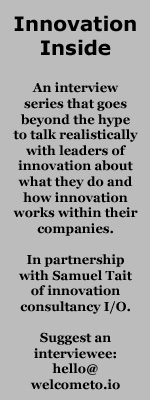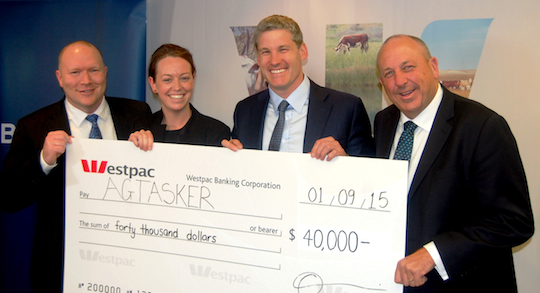How Westpac is delivering innovation
Share
Ian Hill, Westpac’s first group head of innovation, discusses how the bank is approaching innovation delivery. In this interview with Samuel Tait, Hill reveals the processes and measurement tools the Westpac innovation teams are using, as well as giving his take on the importance of culture and his advice for successful innovation programs.
Samuel Tait: How do you and your innovation group sit within the wider Westpac organisational structure?
 Ian Hill: Structure-wise, right now we report through to our COO John Arthur. My team is around 16 people who are roughly aligned to those areas that I alluded to before; innovation strategy, the innovation ecosystem, innovation delivery, innovation advocacy and then external partner networks.
Ian Hill: Structure-wise, right now we report through to our COO John Arthur. My team is around 16 people who are roughly aligned to those areas that I alluded to before; innovation strategy, the innovation ecosystem, innovation delivery, innovation advocacy and then external partner networks.
My group’s aim is to in effect help elevate capability in all the areas of the innovation ecosystem I outlined previously. We set a strategy and direction, making sure that it is being applied in the right areas to ensure we have people bought into the whole idea of innovation in general.
 We have responsibility for uplifting the group in each of these areas and that includes everything from, say, setting up interviews to talk about what we do (like this one) to actually helping groups internally to deliver innovation through providing research and access to The Hive, our 800 square meter innovation centre in Kogarah.
We have responsibility for uplifting the group in each of these areas and that includes everything from, say, setting up interviews to talk about what we do (like this one) to actually helping groups internally to deliver innovation through providing research and access to The Hive, our 800 square meter innovation centre in Kogarah.
ST: What is your approach to innovation delivery?
IH: There are different phases to innovation. You start with the ideation phase then move to incubation phase before finally moving to scale up and launch.
- Ideation: In the ideation phase, you are identifying areas that are ripe for innovation. This could be areas that fit with the particular strategy of the company. It could be areas that when you look at the market seem prime from a profit perspective. It could be areas of customer needs that have developed faster than the market can address them. You prototype, or you build up and test those ideas. Ideally getting some kind of proof of concept that tells you, ‘Yes I’m ready to go out with this idea’.
- Incubation: The incubation phase is where you are actually trying to get the concept out there with customers. Some sort of proof of concept or some kind of minimal viable product or some kind of basic level functionality that you can actually put out there. In effect now customers are giving you real-time feedback as they interact with a limited version of your product.
- Scale up: Especially if you are talking about startup, you ride the incubation wave until you hit some level of scale. Usually at this point you are optimising to figure out how to deal with higher volumes, higher number of customers and higher customer needs.
ST: How are you affecting change within Westpac to drive the success of the innovation capabilities you are putting in place?
IH: There is a notion here that innovation should be everybody’s job. Indeed, when our CEO talks about Westpac being a 200-year-old start-up it is a call to action to that. We also need to make sure that the right tools and processes are in place. That’s one of the big goals of my group – to look across our internal ecosystem and identify where we need additional tools and processes that our people can readily access. For instance, we have an idea capture tool that’s been around for six or seven years now. There are much more advanced and full-featured tools out there for idea capturing, even for crowd sourcing new ideas, is that something that we should replace?
Secondly, there is making sure people have the skills. A big part of what my group does is try to educate people on how to innovate either through training, facilitation or a do-it-yourself online learning tool. How teams can use human-centered design, how to do rapid prototyping, how to create a minimum viable product. Ensuring people know how to use the tools of a startup.
Then finally there needs to be role modeling from people and leaders within the business that in effect convinces everyone that innovation should be the normal way we do things.
ST: How are you using advocacy for innovation within Westpac to support the success of your group in driving outcomes for the business?
IH: There are different forms of advocacy, top-down advocacy or bottom up advocacy and we think about both at Westpac. We definitely try to engage as many people as possible and identify champions who like what we do and who will in effect go off and sing the praises of our group internally.
To some extent getting innovation to happen organically within a business is often a process of engaging your colleagues who in effect are your customers about what it is you do. The more clearly they understand what it is you do and how to engage, the easier it becomes for them to come to you. A good example of that is if one of our division heads wants to do innovative stuff, we encourage them to come talk and run ideas by us and together we work with them to brainstorm and come up with ideas that will lead to a proof of concept and minimum viable product. We have to ensure we earn the right for that to happen. The way we earn that right is by doing good work and then getting people to talk about it. Anybody that engages with us we want make sure has a good experience, that there internal articles written about them and their project, they are put in front of others in the organisation, that they become an advocate for us and for innovation at Westpac.
As a kind of more top down approach, we have advocates in the form of Brian Hartzer our CEO, Dave Curran our CIO and David Lindberg and George Frazis who lead our business and consumer banking efforts, who will send emails and deliver talks within the organisation highlighting that our team is there to help provide services around innovation and promote the outcomes that we provide to different teams within the business.
ST: How does your team operate with the other innovation initiatives within Westpac?
IH: We have sister teams within the Westpac innovation ecosystem, The Garage, The Hive and the Innovation Challenge with BlueChilli are all good examples of this. My team’s focus is on the front of the funnel – identifying customer needs; specifically figuring out customer problems to address generating new potential ideas and concepts, getting those ideas to proof of concept or some kind of prototype. Where my team is about ideation, The Garage is about acceleration. That is accelerating delivery from say a business case or a group of concepts, a minimal viable product or some kind of early implementation and to do this as quickly as possible.
The Westpac Innovation challenge with BlueChilli represents a good source of ideas. We come up with a need area in the bank which for this year was agribusiness. Then the creativity of the startup market helps figure out new ways to solve problems in that area.
In 2014, we looked at real estate and the company RealAs was selected, a website and app made by buyers, for buyers that uses a unique proprietary learning algorithm to provide accurate predictions of sale prices and a forum where buyers can exchange information about individual homes. This year it was Agtasker, a website to which farmers post a job and reach an extended network of casual labour and the founder Ella Shannon has just started off her six months in the incubator with Blue Chilli to commercialise her business. The Innovation Challenge is one of the many ways we can generate good ideas, get them implemented and ultimately accrue benefits for Westpac and our customers.
ST: What specific tools or processes do you use for ideation at Westpac?
IH: We are big fans at Westpac of using human centered design or customer centered design. That happens both in innovation but even just in our day-to-day projects. Really making sure that everything we do is trying to meet an actual need of our customers.
I met Doug Dietz, who’s often talked about in human centred design circles. He was a project manager originally at GE who made MRI machines. He was out on-site looking at one his newly installed MRI machines at a hospital. He was feeling pretty proud of it until he saw the little six-year-old girl that was waiting to go into the machine and get scanned. She was actually mortally terrified (as were her parents). It was then that he came up with the idea of using adventure stories and putting details on the machines to make them look like pirate ships or rocket ships, and all sorts of stuff that created a really fun experience that worked so well that some kids were actually asking, “Mummy, Daddy, can I go again tomorrow?” Figuring out who the right customer is or who the additional stakeholders are involved, figuring out what their needs and emotions and desires are around something is critically important. This is a very powerful role for designers. It is something that my team uses, and something we use more broadly across Westpac.
ST: Do you have a preferred tool or process for when you need to execute on an idea?
IH: I think the concept of minimal viable product is useful. It enables you to develop a smaller more narrow use case version of the product, get it out there and see how customers respond to it. You can then scale up with their feedback in mind. Westpac Emergency Cash is an example of that, it allows customers in an emergency to get money out of an ATM that you’re standing in front of without the need of a debit card. We saw such a good response from customers that we decided that we would make that feature available for all situations not just emergencies.
ST: How important is a company’s ability to respond to change in relation to innovation?
IH: One thing innovation does is often getting people to be comfortable with change or motivated and inspired by change. Having innovation in a company in effect makes the company more change ready, which is useful in this kind of environment.
I think it’s Amazon who will do continuous-release on its code. Whereas your typical company will do it maybe in quarterly drops when they’re going to make a change to the code that’s facing the customer. Amazon just update their code constantly. It means that the act of change is not something that they just do quarterly, but it’s something they do constantly. Change, therefore, becomes a much lower risk for them as it has become a familiar exercise for them.
ST: How do you measure the impacts of innovation or the success of the innovation programs at Westpac?
IH: We are still in the early days at Westpac, so a lot of our measurements are focused on inputs right now. It’s the number of ideas that we have that are being generated; the number of those ideas that get through the pipeline to commercialisation; employees and partners engaging with our innovation hub The Hive (which has just passed the 10,000 visitors mark in its first year of operations) and general numbers on advocacy within the business around innovation.
In the future I think we’ll see percentage of revenue generated from new products or services as measures of success. I think in an ideal world we would also see personal KPIs integrated as a measure, where part of a person’s performance KPI will be around innovation. It’s probably ideal if certain key people across the organisation are measured on innovation or have it as a KPI – although there’s no need for that to be a KPI across the whole organisation.
ST: What do you think is the role of culture in innovation and the value that provides?
IH: I definitely think culture can (depending on the situation) either stifle or accentuate innovation. However I don’t know that there is any one culture recipe that works for all innovation situations. If you take Toyota as an example, they have the largest car assembly factories in the world – they in effect got there by innovating, but they got there through incremental innovation. Everybody across the entire company was empowered to take ownership and improve their own processes and that works with their culture. That’s very different than say a company like Amazon. For them it is about coming up with entirely new businesses – not just online sales but selling storage solutions to creating TV content.
One of the biggest things is cultural alignment between the group that is innovating and the rest of the company. Too often the group that’s innovating will have some kind of mismatch with the culture and/or strategic vision, of the overall innovation, of the overall enterprise. That’s when it’s just hard for an enterprise to nurture and support an innovative culture because the organisational antibodies start going to work.
For innovation to work I think you want a culture that is flexible, a culture that embraces and fosters the spirit and essence of entrepreneurship and that has to be balanced by a business that is also comfortable with failure. I think these feel like the likely candidates but empirically I don’t actually know if those are the ingredients to success.
ST: What advice do you have to help people innovate within their organisations?
IH: I think we probably touched upon it when I talked about some of the tools that we use here. You can’t go wrong following design thinking or including design thinking into your innovation process. Using a fast fail or lean startup methodology to de-risk projects and de-risk them early and figure out where the opportunity is, that’s useful for anybody.
In addition, cross-fertilisation of ideas is probably one of the most important things for innovation; bringing in as many different viewpoints as possible is crucial.
Then I think if you have some innovation that truly breaks the mould relative to your large enterprise, when you are incubating it, do it away from the corporate center. Give it a chance to kind of stand up in a protected way and then incorporate it back into the organisation.
Check out the first part of this interview with Ian Hill from Westpac here.

















